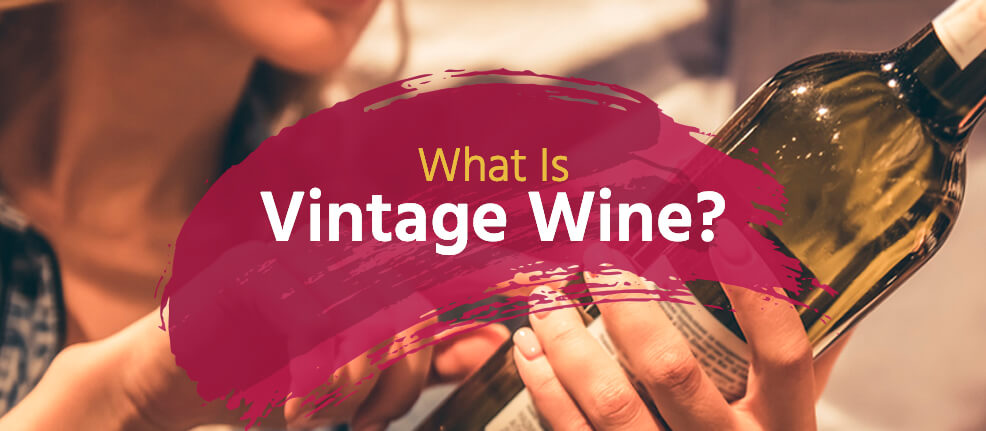
In the world of wine terms, few are as important yet misunderstood as “vintage.”
Written on labels then placed on shelves at your local liquor store, what does it mean for a wine to be “vintage.” Is it aged? Old? Experiencing a sudden resurgence among trendy wine drinkers?
It turns out, what makes wine vintage is far, far simpler.
Table of Contents
- Wine Vintage Definition
- Why Is a Wine’s Vintage Important?
- What Is a Non-Vintage Wine?
- Which Is Better: Vintage or Non-Vintage Wine?
- What Makes a Good Vintage?
- Does Buying Vintage Wine Really Matter?
- When Does a Wine’s Vintage Not Matter?
- How Do Producers Manage Their Vintages?
- How Does Aging Affect Vintages?
- Which Vintage Varietals Age Well?
- When Should I Buy Vintage or Non-Vintage Wines?
- Order Vintage Red and White Wines
Wine Vintage Definition
Wine vintage refers to the year grapes were harvested. Weather and growing conditions vary between seasons, so each wine vintage offers a unique taste and quality.
Finding a bottle’s vintage is relatively straightforward. Simply look for the year printed on the front of the bottle. This number tells you when the grapes inside were ripened, plucked and perfected for drinkers like you to enjoy.
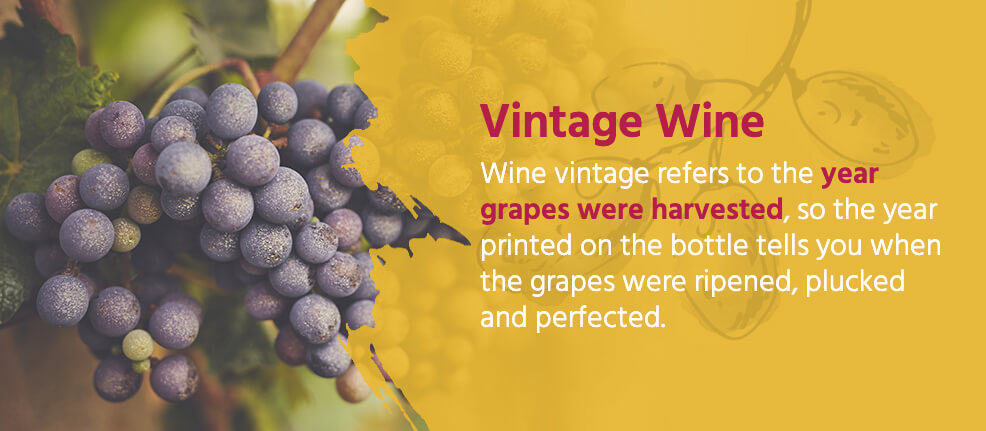
What’s more, wine labels with the world “single vintage” denote a bottle made exclusively from grapes from a single harvest or crop. Depending on the producing country, that ratio must be comprised of 75 to 95% same-crop grapes to legally use the term “single vintage.” As long as a producer abides by that percentage, they can label their bottle as vintage.
Yes, it’s that simple. Where wine novices to certified sommeliers get caught up is how to accurately define a “good” vintage — which we’ll explore below.
Why Is a Wine’s Vintage Important?
There are several key reasons to understand vintages, specifically how those years relate to the region a wine was produced in.
- It signals a bottle’s quality: Understanding vintages lets you discern the quality of a bottle of wine even before trying it. This is because a bottle’s flavors, textures, mouthfeel, aroma and bouquets are fundamentally shaped by its weather and climate conditions during its specific growing season. Since vintage tells you what year those grapes grew, you get an accurate distinction between “good” crop years yielding delicious, balanced wines from “bad” crop years thwarted by poor weather.
- It provides hints for taste and aroma: Vintage wines generally express specific signatures or traits. Drinking vintage wines allows you then to pair specific weather conditions with their end-result flavors and aromas, which can help you determine what kind of wine characteristics you generally enjoy most.
- It signals the mix of grape varietals inside: To be labeled “vintage,” the contents of a bottle must be sourced from 75-95% of the same grape crop. That means three-fourths of a bottle comes from grapes grown at the same time. It does not mean those grapes are identical varietals. Vintage wine blends can contain many different grape varietals mixed and matched together, so long as they were all grown and harvested in the same year.
What Is a Non-Vintage Wine?
Non-vintage wines are wines blending grapes from multiple crops. As a result, they will not have a year printed on the label, or will simply have “N.V.” to denote the fact its contents are not from a single harvest.
Non-vintage wine quality will vary, as with vintage wines. Many are lauded for consistency and cost-consciousness, though, representing a good value for more casual wine drinking.
Which Is Better: Vintage or Non-Vintage Wine?
It depends on what you’re looking for.
There are fantastic bottles of both single vintages and non-vintages available online and in liquor stores. Non-vintages will offer more diversity and flexibility, particularly when it comes to blends combining several complementary grape varietals to produce a creative new favorite. In contrast, vintages provide a deep-dive into a specific wine region, a micro-climate and even a winemaker’s bottling skills and expertise in ways non-vintages can’t.
What Makes a Good Vintage?
Several variables go into determining if a vintage is “good.”
Remember, though, that good wine is often subjective, blurring the taste, aroma, tannin and acidity preferences of the drinker with the objective quality of the harvested grapes and a winemaker’s vinification techniques.
Your preferences may or may not actually align with what the experts herald as a great vintage. Yet knowing what criteria sommeliers and similar wine enthusiasts use to make that call can help you deepen your wine knowledge and selection process.
1. Growing Season Conditions
First and foremost, a good vintage is a reflection of a successful growing season where ideal weather conditions harmonized to produce abundant, flavorful and healthy grapes.
The wine producer assesses these grapes and determines if their harvest holds both the quality and quantity necessary to create single vintages.
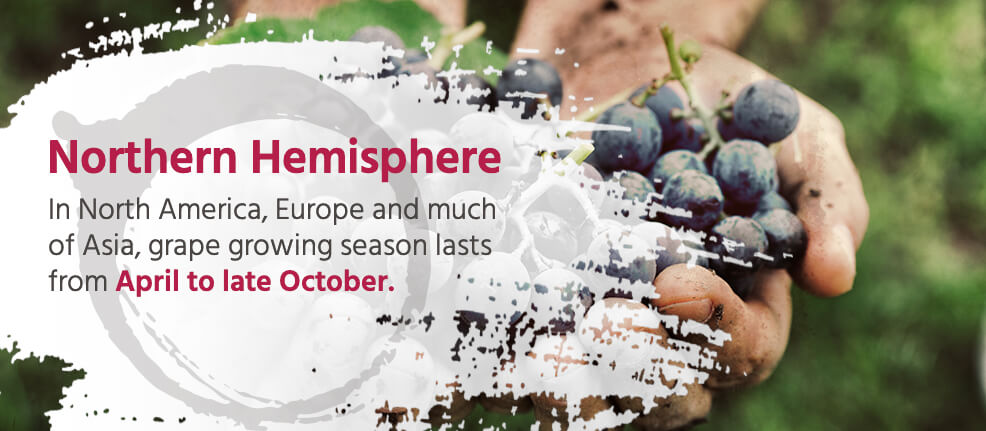
- Northern hemisphere: In North America, Europe and much of Asia, grape growing season lasts from April to late October.
- Southern hemisphere: In South America, Australia, New Zealand and most of Africa, it’s the opposite, with grape growing season beginning in October and lasting till April.
In both hemispheres, it’s the spring, summer and autumn months most responsible for the final quality and characteristics of the grapes. More specifically, for grapes to ripen into single-vintage-worthy batches, the weather across the seasons must typically exhibit these conditions.
- Spring: Frost is the largest enemy of spring grape buds and flowers, particularly in the Northern Hemisphere. While chillier weather is necessary for some grape varietals, such as German Rieslings, too much stunts grape development and could kill portions of a vineyard’s fragile flowering buds.
- Summer: The majority of grape varietal types thrive with modest amounts of rainfall tempered by both direct and indirect sunlight. Ideal summer conditions for vintages balance this rain-and-shine ratio perfectly. Too much rain causes potential rot and fungal diseases in the grapes and vines themselves while too little can actually trigger grape dormancy, with the fruit waiting for milder weather before fully ripening. This offsets the entire grape-growing timeline and potentially inhibits a bountiful end-of-season harvest.
- Fall: Autumn in both hemispheres signals grape harvest time. In these pivotal final two to three months, grapes often require milder temperatures and gentle rainfall to preserve concentrations, stave off rot and fully ripen on time for collection.
There are exceptions to these grape growing conditions and seasons, such as cabernet sauvignon, which requires dry, warm and sunny climates to mature fully.
2. Sunshine
Of all grape climate variables, sunshine is the most critical in determining whether a harvest can produce single vintages or not.
- Proper amounts of sunshine encourage slow but steady grape ripening, developing a varietal’s signature palate between acidity, tannin and sweetness.
- Too little sunshine or too much rain slows grape maturity and causes imbalanced flavors, vine rot and even disease.
3. Temperature
The ideal climate balance necessary for good vintages continues with temperature.
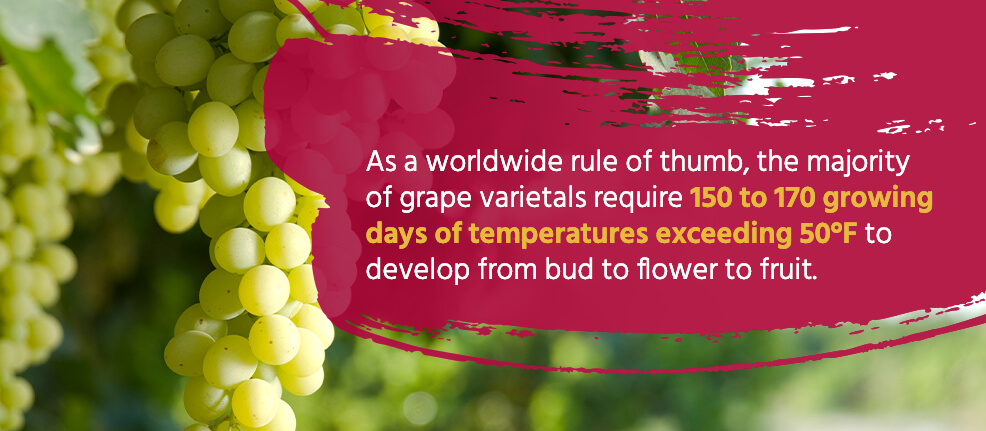
As a worldwide rule of thumb, the majority of grape varietals require 150 to 170 growing days of temperatures exceeding 50°F to develop from bud to flower to fruit.
- Uncharacteristically hot weather expedites most varietal’s maturation, causing them to produce more sugars. Overly sugared grapes tend to succumb to flat, one-note and dimensionless palates.
- Uncharacteristically cold weather triggers the opposite. Grapes without enough warmth cannot nurture proper sugar ratios, resulting in harsher, even acidic profiles.
Does Buying Vintage Wine Really Matter?
Under a few circumstances, yes, selecting vintage wine is preferred over a non-vintage wine or blend.
1. If the Wine Comes From a Variable Climate
Part of what makes wine vintage so special is the way a single vintage tells the story of its past year — and will never tell that same story again.
From rain, frost and humidity to sunshine, soil nutrition and air quality, vintage wine bottles provide the best time snapshot of a particular region’s climates at a particular point in time. These characteristics work into the grapes themselves, causing significant variability in yields and production. One good year in one area may not continue with the next.
Wine-growing regions known for their variable climates exist in both the New and Old World. Sourcing vintages from these places offers opportunities to understand the unique growing conditions and climates of these more unpredictable vines, transporting you to these areas without the expensive plane ticket. Some of these notable climate-variable wine regions include:
- France
- Germany
- Austria
- Northern Italy
- Northern Spain
- New Zealand
- Chile
2. If You’re Starting a Collection
Even novice collectors with only a handful of bottles should pay attention to vintages. Having a selection of wines across the years shows the attention and detail you place on a well-rounded wine cellar in your own home.
Plus, collecting quality vintages from the most renowned wine-producing regions in the world is your ticket to understanding these regions and varietals themselves. From the illustrious green hills of Bordeaux and Burgundy to the chiseled, mountainside vineyards of Chile to the golden plateaus of Australia, every wine-producing region has distinct traits and characteristics to offer that are often best showcased through their single vintages.
In short, you stock your personal wine collection with the best of the best by sourcing renowned vintages from around the world.
When Does a Wine’s Vintage Not Matter?
Again, there isn’t an inherent superiority between vintage and non-vintage wines. Your choice will vary by varietal preference, budget and the general situation you’re buying the wine for.
To keep things simple, though, opt for a non-vintage wine in the following circumstances.
1. When You’re Buying From a Major Producer
Commercialized wines from large producers purposefully create their bottles to be identical across the years.
At their scale, quantity and uniformity are prioritized. Large producers will, therefore, manipulate everything from pH and residual sugar to natural flavors, total acidity and alcohol content, ensuring each bottle is identical to the next in the case. For this reason, give less weight to “vintages” or years printed on mass-produced wine brands.
2. If the Wine Comes From a Stable Climate
Consistent climates yield more consistent crops. Therefore, regions with generally sunny skies, temperate weather and moderate seasonal rain nurture equally predictable crops with a smaller chance for vintage variations.
Such climates producing consistently styled wines include but aren’t limited to:
3. If You Love a Certain Region’s Varietal Already
No need to overthink things here. If you love Loire Valley Chenin Blancs, then get a Loire Valley Chenin Blanc regardless of the vintage or acclaim.
Sure, it’s enjoyable and educational to explore that varietal over the years. You’ll notice subtle differences when you do so. But in the end, if your taste buds have a particular affinity for a specific type of red or white wine, they won’t be biased because of numbers on a bottle.
How Do Producers Manage Their Vintages?
While the term “vintage” itself merely expresses the year the grapes were harvested, many winemakers embrace the nuance and variability that comes with year-to-year grape yields.
This means accepting both good and bad harvests, making the most of each to tell an honest story of the year.
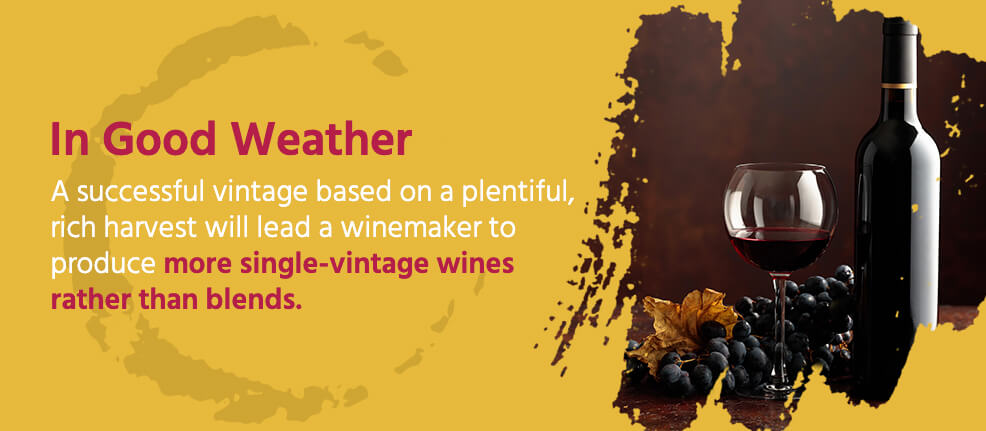
- In good weather: A successful vintage based on a plentiful, rich harvest will lead a winemaker to produce more single-vintage wines rather than blends. When this is the case, a less-is-more mentality is typically called for, with producers letting the beautiful grapes speak for themselves with minimum cellar techniques or manipulation.
- In inclement weather:Even with advanced winemaking tools and technology, grapes are still at the mercy of nature. Less-than-ideal weather and climate conditions can be combated with several vinification and blending tricks. For example, adding particular strains of yeast can temper harsh acidity from under-ripe yields, while employing reverse osmosis can bring down sweetness or alcohol levels from too much sun exposure. Some producers may even include natural or artificial flavors to adjust a varietal’s palate, though still must maintain a 75 to 95% grape base.
In either case, a savvy winemaker knows when to play their cards and when to hold back to create a vintage they’re proud of.
How Does Aging Affect Vintages?
Vintage wines that are cellared undergo ongoing chemical reactions that will last until a bottle is decanted.
These reactions are the result of continuous interactions between the wine’s alcohol, sugar and acid compounds, which mix in their sealed environment to coax new layers of flavors, textures and bouquets. These chemical interactions will continue until a bottle is opened. However, they’re far from random. The most skilled winemakers understand the chemistry behind aging wine and will manipulate the cellar environment to encourage various flavor and aroma nuances, resulting in a delicious, heady and good vintage.
To understand cellaring further, here’s what will — and won’t — happen when vintage wine is aged.
1. Its Signature Flavors Don’t Change
At least not much.
A wine’s primary flavors will always be preserved regardless of cellaring timelines. These primary flavors are a direct result of the underlying grape varietal as well as the conditions the grapes grew in.
To illustrate, regardless of cellaring or not, you should always note the following dominant flavors in these varietal examples:
- Greenery or grass in sauvignon blanc
- Green and black pepper in cabernet sauvignon
- Apricot in Gewurztraminer
- Berries and chocolate in port wine
What aging a vintage varietal will affect are the secondary and tertiary flavors and aromas. Both secondary and tertiary notes are derived from a winemaker’s unique brewing techniques as well as the chemical interactions between a wine’s natural compounds and oxygen molecules. These activities define aging wine. Therefore, it makes sense aging wine only really affects these layers of smells and flavors.
To use the examples from above, secondary flavors common in aged vintages range but might include:
- Slate or wet pavement in sauvignon blanc
- Tobacco in cabernet sauvignon
- Honey in Gewurztraminer
- Cinnamon in port wine
2. Its Mouthfeel Adapts
Mouthfeel, or the way a wine feels as you drink, will also change as a wine ages.
Generally speaking, red and white vintages will have mouthfeel developments as follows:
- White vintages, especially dry whites like sauvignon blanc and chardonnay, tend to become oily, heavy and stickier over the years.
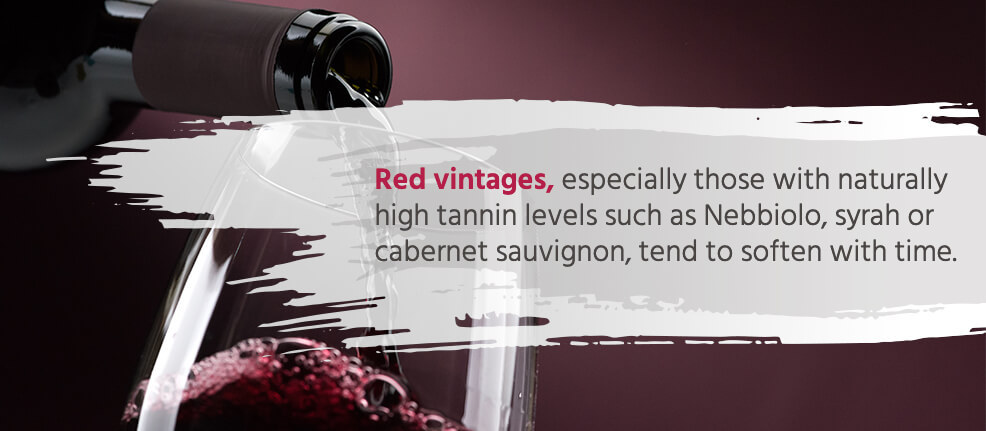
- Red vintages, especially those with naturally high tannin levels such as Nebbiolo, syrah or cabernet sauvignon, tend to soften with time. “Softened” tannins are those which have chemically mixed and matched with one another, forming weighty chains that reduce the total tannin surface area. These chains then sink to the bottom of a bottle and form sediment deposits, many of which you can see. As a result of sediment forming, sips are smoother, less sharp and less prickly, resulting in a gentler drinking experience.
3. Its Color Alters
Color is a third and final characteristic affected by aging vintages.
To tell if a red vintage has been properly aged, first look to its rim, or the outer edge where the wine pour meets the glass. Rims that are lighter indicate an aged red wine, whereas a murky or opaque rim signals a younger bottle.
Second, look at the color of the red vintage itself. As red wines oxidize with age, their colors often muddle from deep shades of ruby-purple to softened mauves and then tawny, deep browns.
In comparison, white vintages tend to move from paler, straw-yellow shades to deeper golden hues. White vintages aged three or more years can eventually darken to the point of turning a golden amber color.
These color alterations are contingent on oxidation. When properly sealed before cellaring, the only oxygen in a bottle will be the small amount trapped in the bottle’s neck as well as what little oxygen can pass through the cork or seal. Most cellared red and white vintages will be sealed with a traditional cork, which allows minimal oxygen to permeate. However, given that cork is itself a natural rather than uniform, human-made product, oxygen permeation will vary significantly even between bottles cellared and cased at the same time.
Which Vintage Varietals Age Well?
To have the most enjoyable vintage wine tasting experience possible, consider these vintage varietals known to age well.
1. Red Vintages That Age Well
The majority of red wine types will age well, given the naturally higher presence of tannins. However, not all reds age equally.
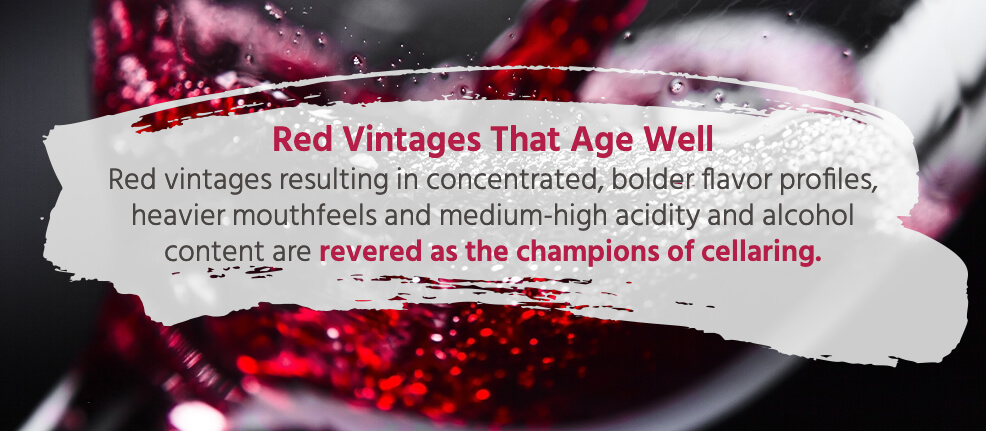
Red vintages resulting in concentrated, bolder flavor profiles, heavier mouthfeels and medium-high acidity and alcohol content are revered as the champions of cellaring. This combination of characteristics from a given year’s yield is a recipe for aging success, allowing winemakers to coax truly complicated yet refined cases for consumers like you.
Again, the quality of a vintage itself will be contingent on a grape’s growing conditions. For concentrated, medium-high acidity red wines, look for these regions and varietals:
- Bordeaux and Loire Valley Cabernet Franc, aged 2 to 4 years
- Chianti Riserva, aged 2 to 4 years
- Petite Syrah, aged 2 to 5 years
- New World Nebbiolo, aged 2 to 6 years
- Australian and Californian Grenache, aged 2 to 10 years
- Italian or Californian Cabernet Sauvignons, aged 3 to 15 years
2. White Vintages That Age Well
Like red wines, vintages from these regions are known for their aging finesse:
- Dry White Bordeaux, aged 2 to 3 years
- Alsace Pinot Gris, 2 to 5 years
- White Rioja, aged 2 to 5 years
- Alsace Gewürztraminer, aged 2 to 10 years
- Californian Fume Blanc, aged 2 to 10 years
- New Zealand Sauvignon Blanc, aged 3 to 10 years
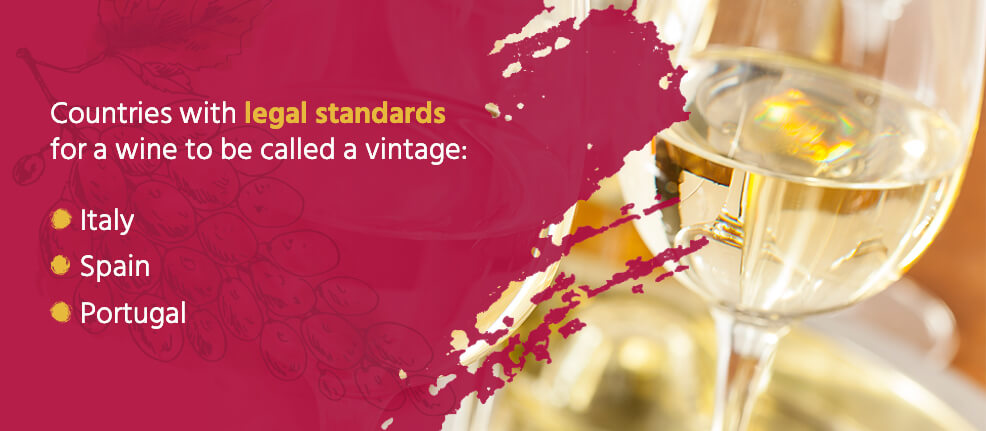
Keep in mind some countries, notably Italy, Spain and Portugal, have legal standards a wine must meet to be called a vintage. When seeking a specific region’s vintages, look for bottles with these terms:
- Italian Riserva
- Spanish Reserva
- Portuguese Reserva
When Should I Buy Vintage or Non-Vintage Wines?
Picking between a vintage or a non-vintage wine is ultimately your call.
You may be attracted to the idea of drinking only heralded bottles from specific regions with exceptional yields — and that’s great! On the other hand, you might want to keep things simple and grab whatever varietal or brand jumps out at you regardless of labels.
To make your decision smoother, we’ve got a few suggestions for when to drink vintage and non-vintage wines.
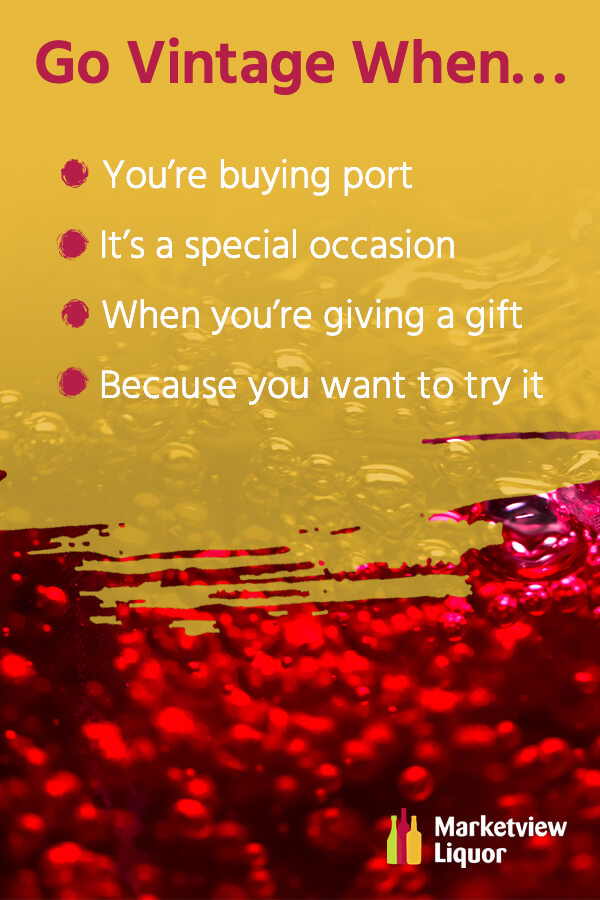
1. Go Vintage When…
Look for bottles labeled “vintage,” “Reserva” or “Riserva” if:
- You’re buying port: Vintage port wines are prized. In fact, experts note as many as five years can pass before northern Portugal — where port grapes grow — yields harvests worthy of the title. Additionally, port must be oak-aged a minimum of two years before its quality is assessed, extending the anticipation over a year’s vintage label or not. Jump at the chance when you see a proper port Reserva. A lot of work — and good fortune — went into that.
- It’s a special occasion: Birthdays, anniversaries, retirements and holidays call for unique vintage wines to commemorate the special occasion.
- When you’re giving a gift: Go the extra mile by gifting a good vintage red or white wine. The recipient may not know what a good vintage wine is, but they’ll certainly appreciate the effort and attention you put into sourcing a special bottle.
- Because you want to try it: Is there any better reason?
2. Stick With Non-Vintage When…
Conversely, non-vintages are a great option if:
- You’re buying in bulk: Hosting a large party, cocktail hour or big celebratory bash? When cases of wine are called for, it’s easier to stock up on more commercial wines or vineyard cases rather than seeking the best vintages.
- You’re looking for something quick and easy: Non-vintages fill the shelves of nearly any liquor, grocery or convenience store, making it a go-to grab for your home bar cart.
- You’re on a budget: Vintage wines are not always more expensive. In fact, it’s a common misconception that drinking vintages means spending outrageous amounts on your bottle selections. However, many of the most economical wines on the market come from mass-producing wineries — ones with recipes precisely calculated to produce near-identical bottles across the years. When uniformity is the goal, it makes sense to stick with the more cost-effective non-vintages you’re already familiar with.
Order Vintage Red and White Wines
Marketview Liquor makes finding high-quality wines easy. Whether you’re looking for unique vintages to celebrate a special occasion or a case of non-vintages for everyday drinking, we can ship wine right to your door.
Explore our vintage and non-vintage wine catalog today to place your order.

